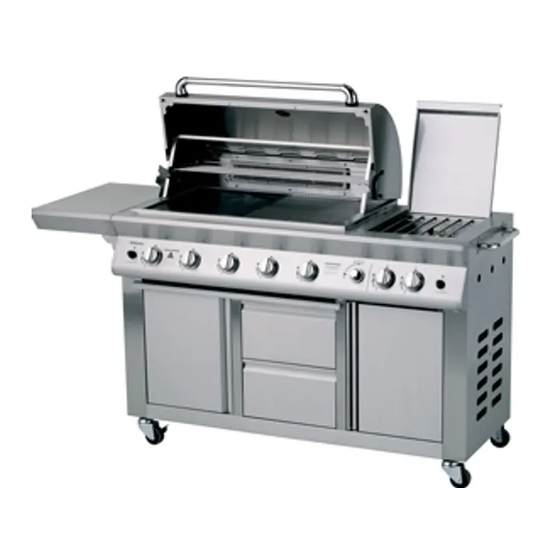
Advertisement
Outdoor Kitchen
Owners Operation Manual
D o n o t o p e r a t e t h i s a p p l i a n c e b e f o r e r e a d i n g t h e s e i n s t r u c t i o n s
This appliance shall be installed and operated in
accordance with:
These instructions
Current AS 5601 'Gas Installations'
Any other local relevant Statutory Regulations
For Models:
Gourmet 4
Gourmet 5
Impressor 5
Impressor 8
Impressor 10
Distributed and serviced in Australia under a Quality
All Rinnai gas products
System certified as com plying with ISO 9001 by
are A.G.A. certified.
SAI Global
Advertisement
Table of Contents

Summarization of Contents
Safety Information
Gas Cylinder Safety and Use
Guidelines for safe storage, connection, and usage of gas cylinders.
Hose and Regulator Guidelines
Proper use, inspection, and replacement of gas hoses and regulators.
Leak Testing Procedure
Step-by-step instructions for checking gas connections for leaks using soapy solution.
Gas Cylinder Removal
Safe procedure for disconnecting and removing the gas cylinder from the barbecue.
Clearances and Location
Required Clearances
Specifies minimum safe distances from the barbecue to surrounding objects and surfaces.
Outdoor Location Requirements
Defines suitable outdoor placement, ventilation, and stable surface criteria.
Vehicles and Boats Installation
Special safety aspects and professional installation requirements for vehicles and boats.
Assembly & Testing
Tools and Unpacking Instructions
Lists necessary tools and outlines the initial unpacking and inspection process.
Impressor Series Assembly Steps
Detailed instructions for assembling Rinnai Impressor series barbecues.
Gourmet Series Assembly Steps
Detailed instructions for assembling Rinnai Gourmet series barbecues.
Burner and Ignition System Checks
Verifying correct positioning and functionality of burner and ignition components.
Ignition System Testing
Procedures for testing the electronic and piezo ignition systems for spark generation.
Burner Operation Testing
Steps to test individual burner ignition, cross-ignition, and flame characteristics.
Flame Tamer and Grill Installation
Correct placement of flame tamers, hot plates, and grills within the barbecue firebox.
How to Use
Initial Preparation and Burning Off
Pre-use checks, safety reminders, and the initial burn-off procedure.
Rotisserie Motor Operation
Instructions for connecting and operating the rotisserie motor safely.
Burner Ignition and Control
Guides for lighting burners via electronic ignition and manual methods.
Cooking
Burner Settings and Hood Usage
Guidance on selecting burner levels (high, medium, low) for various cooking methods.
Convection and Radiant Cooking
Techniques for convection cooking and using the rotisserie for radiant heat.
Rotisserie Handle and Temperatures
How to use the rotisserie handle and recommended internal cooking temperatures.
Special Cooking Methods
Instructions for using the smoke box, warming rack, and side burner.
Storage
General Storage Precautions
Advice on covering the barbecue and protecting it from the elements during storage.
Gas Cylinder Storage Rules
Critical safety rules for storing gas cylinders outdoors and away from enclosed areas.
Cleaning and Maintenance
General Cleaning Guidelines
Recommendations for regular cleaning frequency and general maintenance tips.
Cleaning Cooking Surfaces
Procedures for cleaning hot plates, grills, flame tamers, and drip trays effectively.
Cleaning Burner Tubes
Steps to inspect and clean burner tubes to prevent flashback and ensure proper combustion.
Trouble Shooting
Burner Ignition Problems
Troubleshooting steps for burners that fail to ignite using the igniter.
Flame and Gas Leak Issues
Diagnosing and resolving erratic flames, soot, or gas leaks from connections.
Other Common Problems and Service
Addressing issues like stiff controls, hood fit, and when to contact service.












Need help?
Do you have a question about the Gourmet 5 and is the answer not in the manual?
Questions and answers